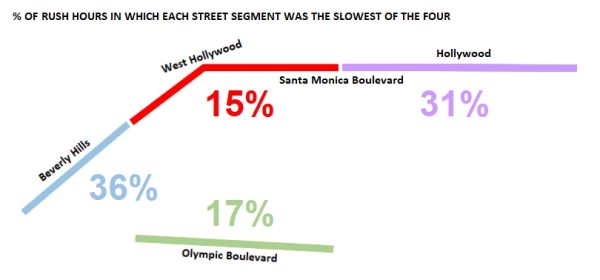
West Hollywood’s rush-hour traffic is not usually the slowest or the fastest among four nearby areas. However, the city’s non-rush-hour traffic is often the slowest of the four. That is according to a new report by WeHo by the Numbers.
The report does not try to compare speeds on all streets in West Hollywood to all streets in nearby communities. Instead, it compares speed estimates for Santa Monica Boulevard in Beverly Hills, West Hollywood, and Hollywood, plus a stretch of Olympic Boulevard. The speed estimates are for driving from one end of the city to the other, including time spent at red lights.
“In a limited sample from last year, the drive across West Hollywood on Santa Monica Boulevard took an estimated 7 to 24 minutes. The same data source suggests the trip can take up to 40 minutes, but times like that were not captured in the sample. The biggest delays were mostly during the rush hours. Many non-rush hours also exhibited significant delays.
During a recent sample period in West Hollywood, the fastest end-to-end speeds were around 25 miles per hour. The slowest speeds were under 10 miles per hour. About 95% of the times with the slowest speeds were rush hours. Speeds in non-rush hours were higher, though not necessarily high. For example, 70% of the times that speeds were between 10 and 15 miles per hour were during non-rush hours.
West Hollywood’s rush-hour traffic was rarely the slowest among the four areas. That occurred only 15% of the time during rush hours. That was similar to the situation on Olympic Boulevard (17%). Beverly Hills and Hollywood, on the other hand, had the slowest traffic 36% and 31% of the time, respectively.
West Hollywood had the fastest rush-hour traffic only 16% of the time. Olympic was the rush-hour winner, with higher speeds 38% of the time.
The pattern was different for non-rush-hour traffic. West Hollywood’s non-rush-hour traffic on Santa Monica Boulevard was often the slowest of the four in the sample period. It was the slowest 73% of the time and the fastest only 3% of the time. The slower non-rush-hour speeds were spread across weekdays and weekends, days and nights. Saturday night stood out.
The Beverly Hills (8%), Hollywood (9%), and Olympic (10%) street segments were rarely the slowest during non-rush hours. Olympic was the fastest almost half the time.
To find out more, see the full report, Is traffic slower in West Hollywood than nearby areas?

Thank you, Josh and Alan! The article has been revised to say what I should have said in the first place: the numbers are based on a limited sample. I completely agree that driving from one end of the city to the other can take longer. The sample just doesn’t happen to include those times. I hope readers will find the results of the comparison to nearby streets intriguing, despite the limited sample.
Unless I’m reading this wrong, 24 minutes to get between Doheny and La Brea doesn’t seem correct during rush hour. It seems on some mornings, driving from Fairfax to Doheny takes at least 24 minutes…. I’m not sure how Olympic plays into this, but it seems to me one could argue that during peak times when traffic is slower in West Hollywood than in Beverly Hills, it could be a result of our residents using their vehicles for local trips, in many cases unnecessarily. (while I’m sure there are customers of Trader Joe’ s guilty of this, I’m primarily thinking… Read more »
The following quote from this article is a curious statistic that doesn’t paint an accurate picture: “The slowest speeds were under 10 miles per hour.” I’m a firm believer in science and studies, but statistics can be misused to misleading ends. My own anecdotal evidence, supported by several years of commuting between Century City and West Hollywood, paints a picture of slowest speeds often at the less than four miles per hour. I can show you logs of 3.2 mile trips that took 50-61 minutes, the worst of it was not Beverly Hills, but always West Hollywood.
How I completely beat the traffic problem even during peak rush hour is by electric scooter. 🛵 High speed, low Environmental Impact ♻️, easy to park and, cost effective! Best of all I can pester rich people jammed in traffic by letting them know that their expensive cars are causing more problems than they are solving. For that matter we should seriously consider banning private fossil fuel powered vehicles from the streets of the Great City of West Hollywood completely, just like the Third Street Promenade in Santa Monica. We would be much better off if the City was accessible… Read more »
I’m with you 100%. Scooter all the way
Are you serious?
Not only do we and surrounding cities depend upon our WeHo streets as crucial arteries for automobile traffic, but these dippy scooters are dangerous for riders as well as for any pedestrian or car they happen to speed past – not to mention how they have already cluttered up our sidewalks and public areas to become a new picture of urban blight. If someone will put a proposition on our next ballot to outlaw these scooters, I’d line up a week early to vote for it.
If you read any of my other posts, you would realize just how serious I am about this. The age of the automobile is about to be over and, a car-free West Hollywood is a good start for a Car-Free Los Angeles and Southern California. It’s the fossil fuel internal combustion drive automobiles that are the real problem when it comes to Adverse Environmental Impacts, urban blight and, posing a threat to public safety on the level of fire arms. The alternative is much better! A world with Electric Scooters, free public mass transit via mag-lev trains and, something new… Read more »